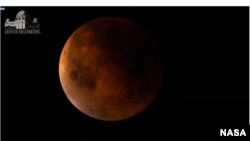Stargazers in all over the world were treated to a rare astronomical phenomenon when a total lunar eclipse coincided with a so-called supermoon.
Sky-watchers came out late Sunday and early Monday to watch the shadow of Earth cast a reddish glow on the moon, the result of rare combination of an eclipse with the closest full moon of the year.
The celestial event, also known as a "blood moon," was visible in North and South America, parts of Europe, North Africa and Western Asia.
The "supermoon" is one that appears bigger and brighter than usual as it reaches the point in its orbit that is closest to Earth.
Because the moon's orbit is not perfectly round, its distance from Earth varies by about 49,900 kilometers as it circles around the planet every 27 days.
At its closest point, known as perigee, the moon comes as close as 363,104 km to the Earth. At apogee, the most distant point, the moon is 406,696 kilometers away.








